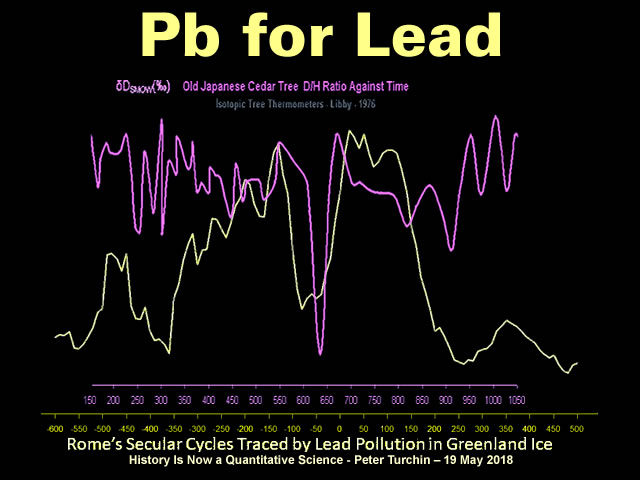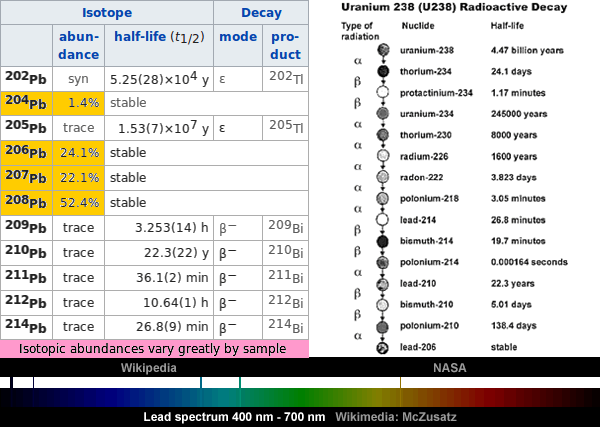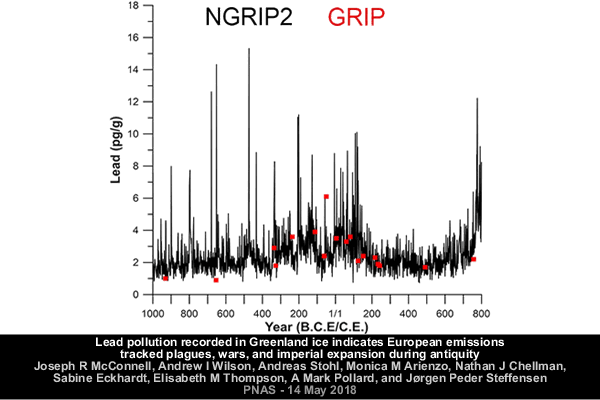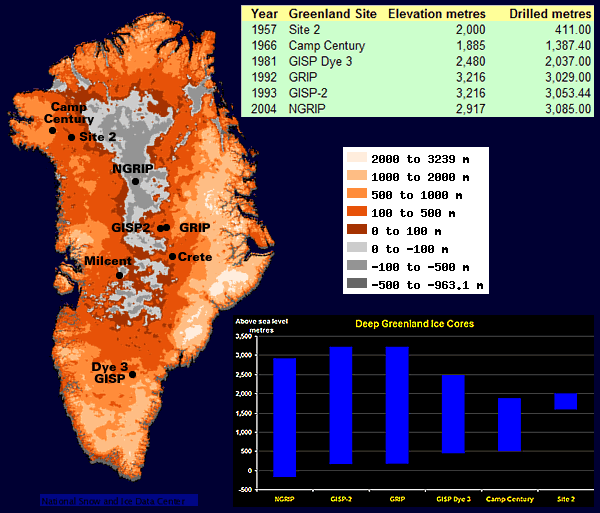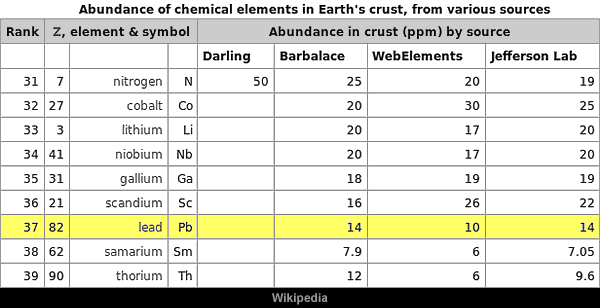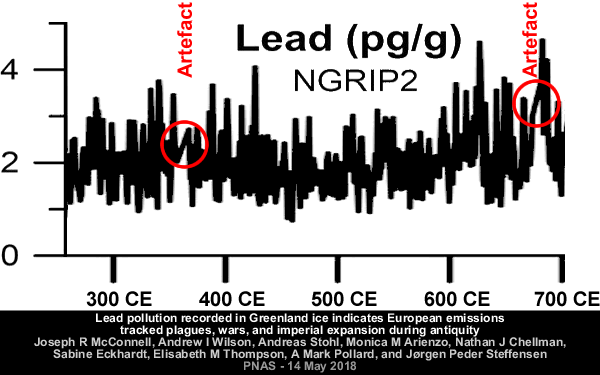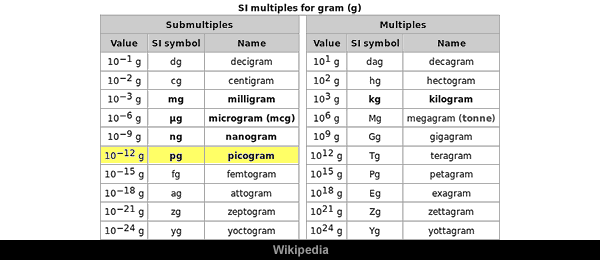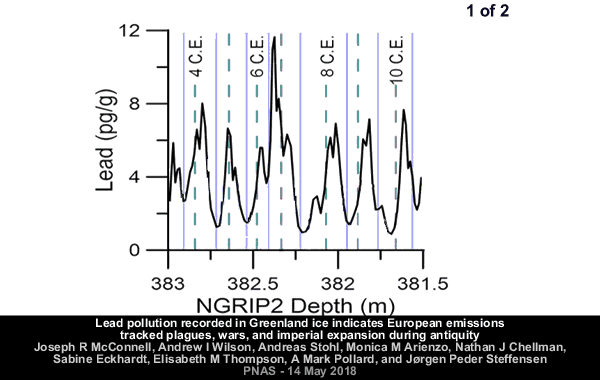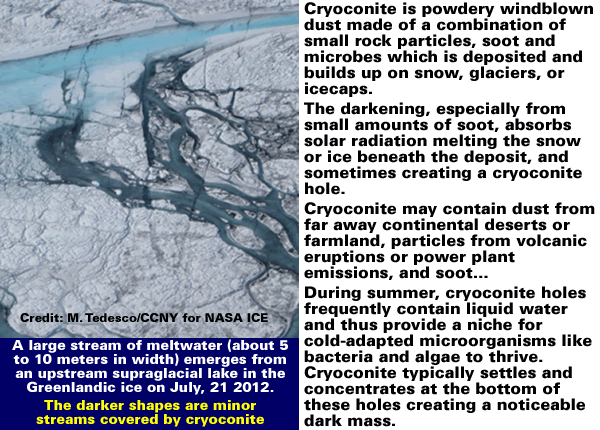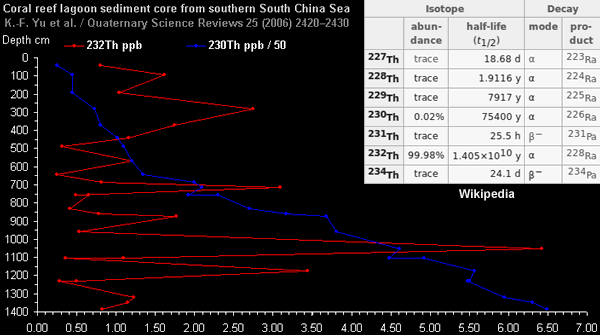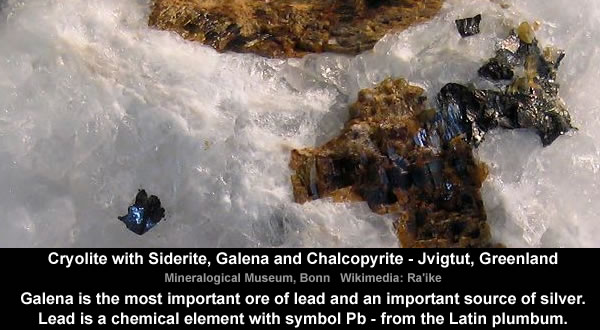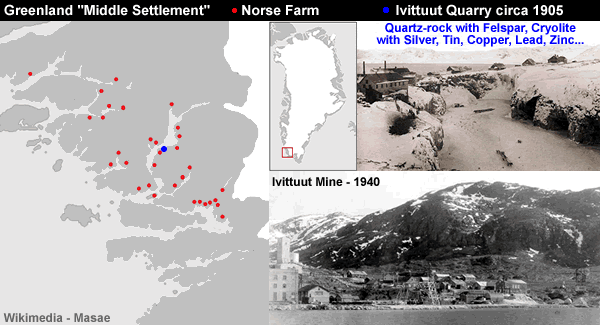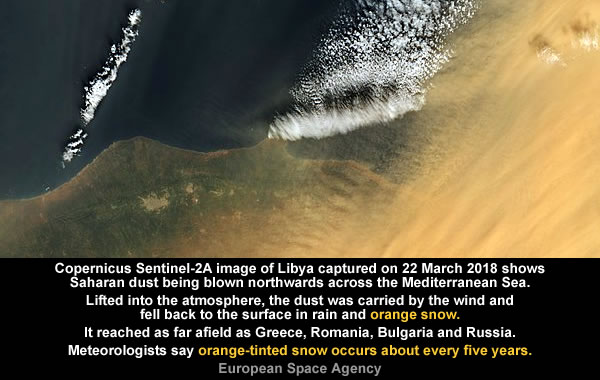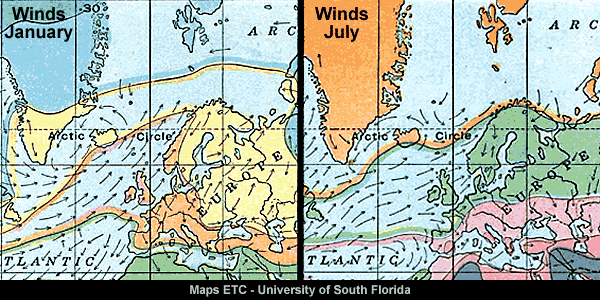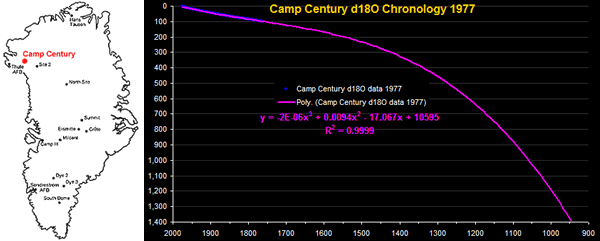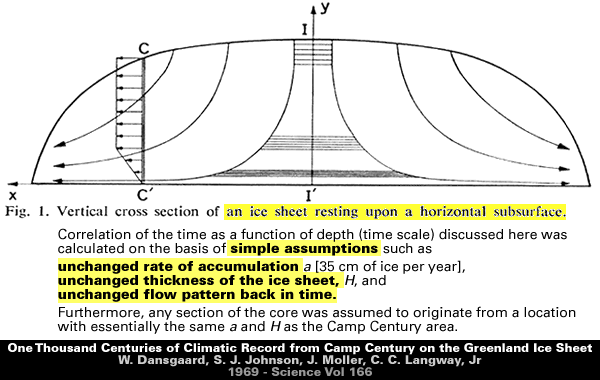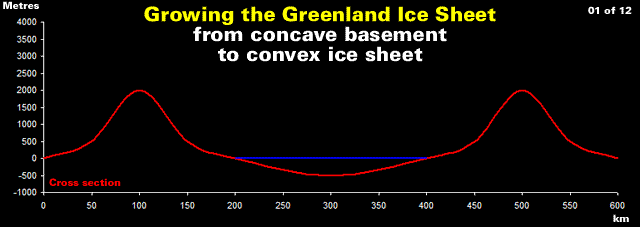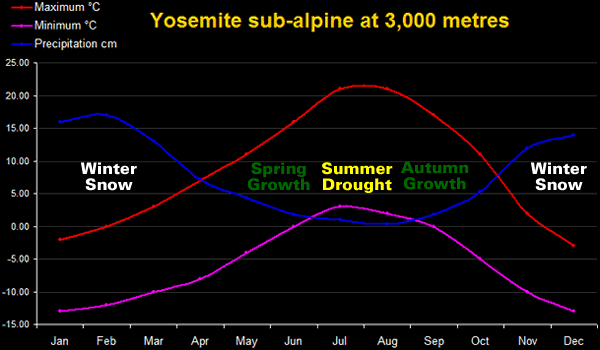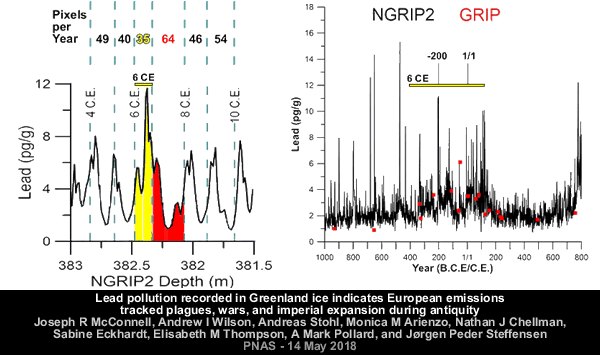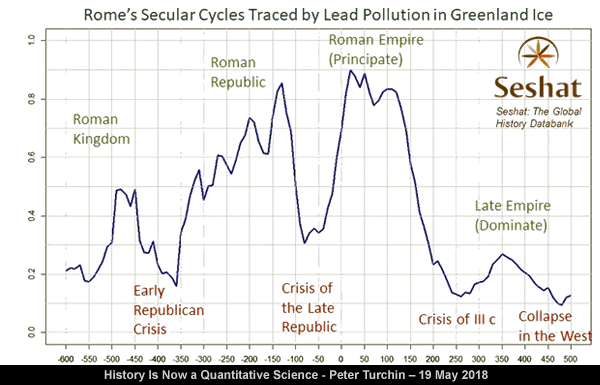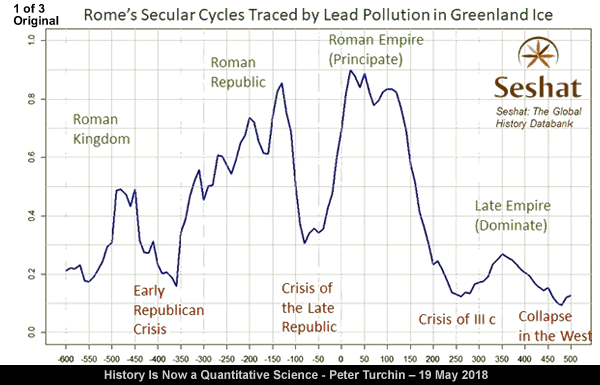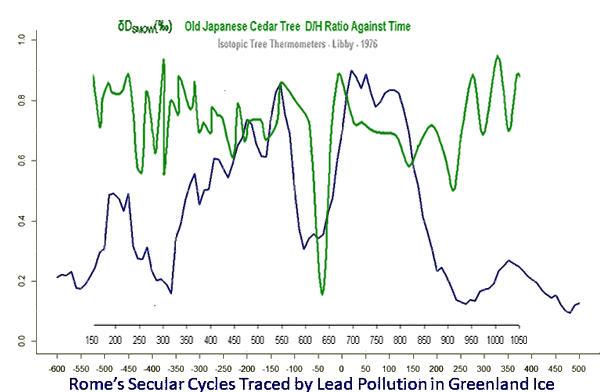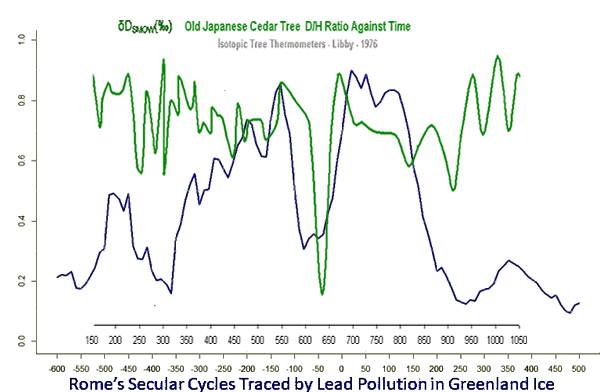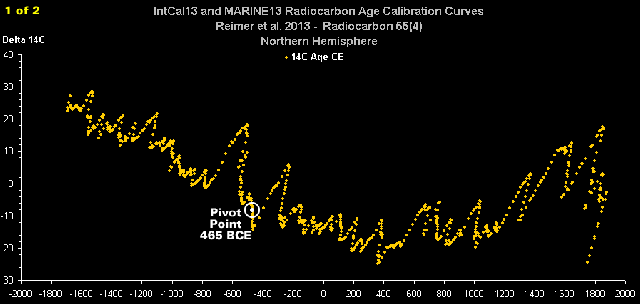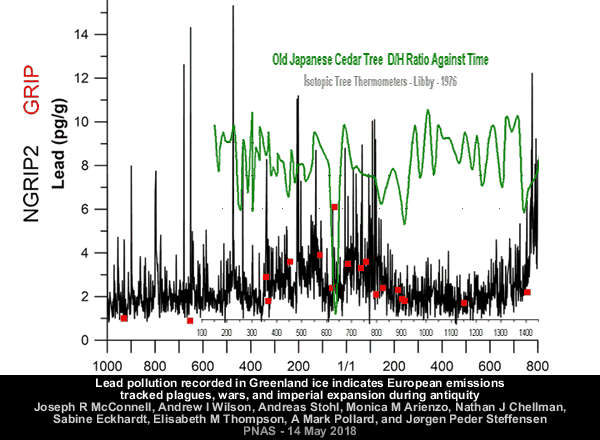The mainstream attempt to combine the Settled Science of Lead Pollution in Greenland Ice Cores with the Settled History of the Roman Era is a very revealing train wreck.
The Settled Science of Lead
Settled Science has a couple of problems with Lead.
Firstly, it’s difficult to explain away why “isotopic abundances vary greatly by sample”.
Three of the stable isotopes are found in three of the four major decay chains: lead-206, lead-207, and lead-208 are the final decay products of uranium-238, uranium-235, and thorium-232, respectively.
…
For example, the relative abundance of lead-208 can range from 52% in normal samples to 90% in thorium ores; for this reason, the standard atomic weight of lead is given to only one decimal place.
Secondly, the mainstream have decreed that Lead-204 is “entirely a primordial nuclide” so they can pretend their uranium and thorium “dating schemes” [with an emphasis on “schemes”] are meaningful and [somehow] consistent with their theological “Big Bang” beliefs.
Lead-204 is entirely a primordial nuclide and is not a radiogenic nuclide.
https://en.wikipedia.org/wiki/Isotopes_of_lead
In geochemistry, geophysics and geonuclear physics, primordial nuclides, also known as primordial isotopes, are nuclides found on Earth that have existed in their current form since before Earth was formed.
Primordial nuclides were present in the interstellar medium from which the solar system was formed, and were formed in the Big Bang, by nucleosynthesis in stars and supernovae followed by mass ejection, by cosmic ray spallation, and potentially from other processes.
https://en.wikipedia.org/wiki/Primordial_nuclide
204Pb is entirely primordial, and is thus useful for estimating the fraction of the other lead isotopes in a given sample that are also primordial (since the relative fractions of the various primordial lead isotopes is constant everywhere).[citation needed]
Any excess lead 206, 207, and 208 is thus assumed to be radiogenic in origin,[citation needed] allowing various uranium and thorium dating schemes to be used to estimate the age of rocks (time since their formation).
https://en.wikipedia.org/wiki/Isotopes_of_lead
Lead, in particular , is much more abundant than expected, if it is only produced in supernova explosions.
A radiogenic nuclide is a nuclide that is produced by a process of radioactive decay.
Lead Pollution in Greenland Ice Cores
Explaining away the lead pollution in the Greenland Ice Cores is an interesting challenge.
http://www.pnas.org/content/early/2018/05/08/1721818115
See: https://malagabay.wordpress.com/2014/12/09/the-great-greenland-snow-job-07-bending-time/
1) There is a natural background level of atmospheric lead pollution that can be attributed to cosmic dust and the erosion of terrestrial rocks.
Cosmic dust, also called extraterrestrial dust or space dust, is dust which exists in outer space, as well as all over the Earth. Most cosmic dust particles are between a few molecules to 0.1 µm in size. … as much as 40,000 tons of cosmic dust reaches the Earth’s surface every year…
https://en.wikipedia.org/wiki/Cosmic_dust
https://en.wikipedia.org/wiki/Abundance_of_elements_in_Earth%27s_crust
This natural background level of lead pollution in the NGRIP2 Greenland Ice Core appears to vary between 1 and 3 pg/g per annum. Arguably, the variance is primarily influenced by wind direction, levels of precipitation and the subsequent ablation/evaporation/melting of the precipitation.
http://www.pnas.org/content/early/2018/05/08/1721818115
Note
The diagonal artefacts in the NGRIP2 lead trace suggest there are gaps in the data.
A closer look at the lead pollution trace from the NGRIP2 Greenland Ice Core is very revealing.
a) There appears to be a distinct annual pattern.
b) It’s arguable whether the spikes in lead pollution represent:
b1) An overall rise in atmospheric lead pollution levels
and/or
b2) An ablation/evaporation/melting event that concentrated the lead pollution.
c) The adjacent outlier years [the highlighted 35 and 64 pixels per year] suggest there are probably temporal discontinuities and phantom years in the ice core data.
http://www.pnas.org/content/early/2018/05/08/1721818115
See: https://malagabay.wordpress.com/2014/12/05/the-great-greenland-snow-job-06-the-64000-question/
2) The unexplained spikes in Thorium [found in South China Sea sediments] suggest there will be similar unexplained spikes in Thorium decay products – such as lead – in the Greenland Ice Cores.
See: https://malagabay.wordpress.com/2017/08/21/thorium-230-chinese-corals/
See: https://malagabay.wordpress.com/2017/09/15/the-atomic-comet-the-thorium-connection/
3) The levels of lead pollution in the Greenland Ice Cores are influenced by human activity such as the mining and smelting of lead ores.
https://en.wikipedia.org/wiki/Galena
See: https://malagabay.wordpress.com/2017/01/19/the-red-score-tin-talks/
The Settled Science of Lead Pollution in Greenland Ice Cores
According to Settled Science the varying levels of lead found in the Greenland Ice Cores are a proxy for silver mining during ancient times.
The amount of lead deposited in Greenland can be resolved down to the year.
As a result, Greenland ice contains an excellent quantitative proxy for the intensity of silver production…
History Is Now a Quantitative Science – Peter Turchin – 19 May 2018
http://peterturchin.com/cliodynamica/history-is-now-a-quantitative-science/
Unsurprisingly, the Settled Science interpretation of the proxy data glosses over the possibility that catastrophic natural disasters might have occurred during ancient times.
This week an interdisciplinary team of climatologists and archaeologists published an article, Lead pollution recorded in Greenland ice indicates European emissions tracked plagues, wars, and imperial expansion during antiquity.
History Is Now a Quantitative Science – Peter Turchin – 19 May 2018
http://peterturchin.com/cliodynamica/history-is-now-a-quantitative-science/
The Settled Science specifically associates the lead particles found in the Greenland Ice Cores with “Iberian silver mines” during “Antiquity”.
The main source of lead particles, deposited on Greenland ice during Antiquity, was a result of smelting silver in Iberian silver mines.
History Is Now a Quantitative Science – Peter Turchin – 19 May 2018
http://peterturchin.com/cliodynamica/history-is-now-a-quantitative-science/
This attribution is very difficult to justify when the mapped levels of lead pollution indicate Greenland was the red hotspot source of the lead pollution.
Lead pollution in Arctic ice reflects midlatitude emissions from ancient lead–silver mining and smelting. The few reported measurements have been extrapolated to infer the performance of ancient economies, including comparisons of economic productivity and growth during the Roman Republican and Imperial periods. These studies were based on sparse sampling and inaccurate dating, limiting understanding of trends and specific linkages.
Here we show, using a precisely dated record of estimated lead emissions between 1100 BCE and 800 CE derived from subannually resolved measurements in Greenland ice and detailed atmospheric transport modeling, that annual European lead emissions closely varied with historical events, including imperial expansion, wars, and major plagues.
Emissions rose coeval with Phoenician expansion, accelerated during expanded Carthaginian and Roman mining primarily in the Iberian Peninsula, and reached a maximum under the Roman Empire.
Emissions fluctuated synchronously with wars and political instability particularly during the Roman Republic, and plunged coincident with two major plagues in the second and third centuries, remaining low for >500 years.
Bullion in silver coinage declined in parallel, reflecting the importance of lead–silver mining in ancient economies.
Our results indicate sustained economic growth during the first two centuries of the Roman Empire, terminated by the second-century Antonine plague.
Lead Pollution Recorded in Greenland Ice Indicates European Emissions
Tracked Plagues, Wars, and Imperial Expansion During Antiquity
Joseph R McConnell, Andrew I Wilson, Andreas Stohl, Monica M Arienzo, Nathan J Chellman, Sabine Eckhardt, Elisabeth M Thompson, A Mark Pollard, and Jørgen Peder Steffensen – PNAS – 14 May 2018
http://www.pnas.org/content/early/2018/05/08/1721818115
This attribution is also very difficult to justify when Saharan Sand from Libya [for example] only very occasionally reaches as far North as Sochi in South West Russia.
Skiers and snowboarders were met with orange-tinted snow in Sochi, Russia, this weekend. The usually powdery white snow turned colors due to a sandstorm that blew across the Sahara Desert in North Africa.
Orange Snow Blankets Parts of Russia – Amanda Jackson – 26 March 2018 – CNN
https://edition.cnn.com/2018/03/25/world/orange-snow-russia-trnd/index.htmlSochi is a city in Krasnodar Krai, Russia, located on the Black Sea coast near the border between Georgia/Abkhazia and Russia.
Furthermore, the attribution is very difficult to justify given the prevailing winds over the Atlantic.
Maps ETC – University of South Florida
http://etc.usf.edu/maps/pages/4600/4634/4634.htm
http://etc.usf.edu/maps/pages/4600/4636/4636.htm
I guess their “detailed atmospheric transport modeling” must be very sophisticated.
Here we show, using a precisely dated record of estimated lead emissions between 1100 BCE and 800 CE derived from subannually resolved measurements in Greenland ice and detailed atmospheric transport modeling, that annual European lead emissions closely varied with historical events, including imperial expansion, wars, and major plagues.
Lead Pollution Recorded in Greenland Ice Indicates European Emissions
Tracked Plagues, Wars, and Imperial Expansion During Antiquity
Joseph R McConnell, Andrew I Wilson, Andreas Stohl, Monica M Arienzo, Nathan J Chellman, Sabine Eckhardt, Elisabeth M Thompson, A Mark Pollard, and Jørgen Peder Steffensen – PNAS – 14 May 2018
http://www.pnas.org/content/early/2018/05/08/1721818115
And this “modeling” is probably too sophisticated to consider the very real possibility that lead mining and smelting was performed in Greenland during ancient times.
See: https://malagabay.wordpress.com/2014/11/25/the-great-greenland-snow-job-02-camp-century-strata/
And last, but not least, is the possibility is that the ores used to create this tin-bronze alloy came from the Evigtok quarry in the Middle Settlement of Greenland which [amongst other things] contains: copper, tin and argentiferous galena [lead with some silver].
See: https://malagabay.wordpress.com/2017/01/25/the-red-score-the-baffin-crucible/
The Settled Science of Greenland Ice Core Chronologies
The huge problems associated with Ice Core Chronologies can be traced back to the “simple assumptions” made by Willi Dansgaard when he invented his Sandwich Model for the Camp Century Ice Core extracted from the Greenland Ice Sheet.
Sadly, Willi Dansgaard’s “simple assumptions” are completely detached from reality.
See: https://malagabay.wordpress.com/2017/06/12/the-great-greenland-snow-job-09-willis-wonky-wafers/
Earth Scientists believe they can avoid Willi Dansgaard’s modelling problems by simply counting down through the annual layers they have identified in the Greenland Ice Sheet until they reach ancient times.
The Earth Scientists simply assume the layers they have identified in the Ice Sheets are annual layers – just like they assume tree rings are annual tree rings.
Once again, these simple assumptions are flawed in marginal environments where multiple rings / layers can be generated during a year – or even omitted completely in extremis.
See: https://malagabay.wordpress.com/2014/08/26/dendrochronology-death-and-double-counting/
72°34′46.50″N 38°27′33.07″W
Summit Camp, also Summit Station, is a year-round research station on the apex of the Greenland Ice Sheet. Its coordinates are variable, since the ice is moving. The coordinates provided here are as of July 2009. The station is located 3,216 metres (10,551 ft) above sea level.
https://en.wikipedia.org/wiki/Summit_Camp
https://journals.ametsoc.org/doi/pdf/10.1175/1520-0450%282001%29040%3C0741%3AADYOTO%3E2.0.CO%3B2
When the air contains little water, this lapse rate is known as the dry adiabatic lapse rate: the rate of temperature decrease is 9.8 °C/km (5.38 °F per 1,000 ft) (3.0 °C/1,000 ft).
However, in this particular instance, the lead pollution in the NGRIP2 Greenland Ice Core is difficult to reconcile because it appears a [roughly] 200 year discrepancy has been introduced into their analysis.
Peter Turchin has produced an alternate “smoothed” view of the Greenland lead pollution data.
This week an interdisciplinary team of climatologists and archaeologists published an article, Lead pollution recorded in Greenland ice indicates European emissions tracked plagues, wars, and imperial expansion during antiquity.
…
I downloaded the raw data, smoothed it using kernel regression with bandwidth = 50 years (if anybody cares for such technical details), and here is the trajectory (concentration of lead in Greenland ice) during the period when Rome was one of, or the dominant power in Western Mediterranean:History Is Now a Quantitative Science – Peter Turchin – 19 May 2018
http://peterturchin.com/cliodynamica/history-is-now-a-quantitative-science/
This “smoothed” view of the lead pollution data clearly highlights the Arabian Horizon that is centred around 637 CE in Leona Libby’s Old Japanese Cedar Tree Chronology.
See: https://malagabay.wordpress.com/2016/04/08/digitised-japanese-isotopic-tree-thermometer/
The alignment of these two data sources – where 1 AD aligns approximately with 675 CE – provides very tangible support for Gunnar Heinsohn’s observation that the mainstream historical narrative of the 1st millennium contains 700 phantom years.
One of the more striking features of this alignment is the synchronicity of the inflection points between [roughly] 200 CE and 550 CE.
Between 550 CE and 675 CE the Greenland Ice Core acquires about 25 phantom years.
But, as predicted, the production of phantom years in the Greenland Ice Core only goes into overdrive after the Heinsohn Horizon in 912 CE.
See: https://malagabay.wordpress.com/2014/11/25/the-great-greenland-snow-job-02-camp-century-strata/
It’s also very intriguing to note that the period of remarkable inflection point synchronicity beginning in [roughly] 200 CE is fairly closely aligned with the 465 BC Pivot Point in the mainstream Radiocarbon Calibration Curve.
See: https://malagabay.wordpress.com/2017/04/05/deranged-dating-the-slanted-science/
Overall, the results suggest a more accurate rendition of Gunnar Heinsohn’s hypothesis would be:
The historical narrative contains 700 phantom years between 500 BC and 1000 AD.
With regard to the historical narrative and Greenland lead mining/smelting the synchronised data suggests there was possibly some activity between 300 BC and 150 BC [aka 400 CE to 550 CE] followed by a recovery between 1 AD and 100 AD [aka 700 to 800 CE].
Note:
Upward spikes in the Greenland Lead Trace that are associated with a significant downward spike in the Japanese D/H Ratio are indicative of a large scale natural disaster/catastrophe.
Currently, there is no evidence to indicate any of the [inferred] lead mining and smelting activity in Greenland was performed by the Romans.

